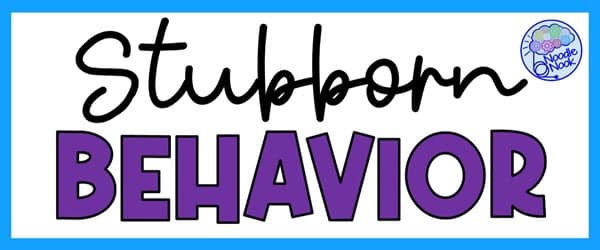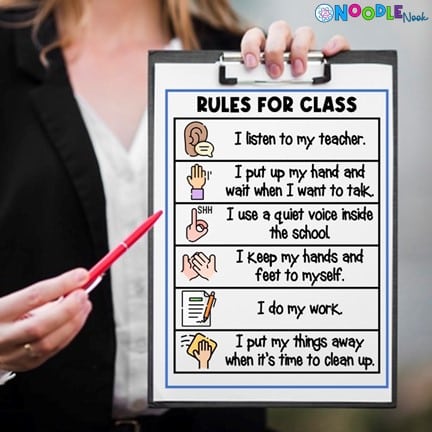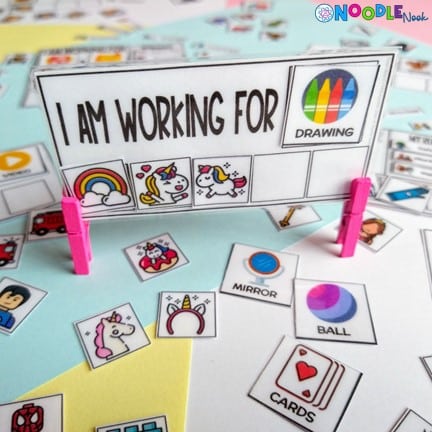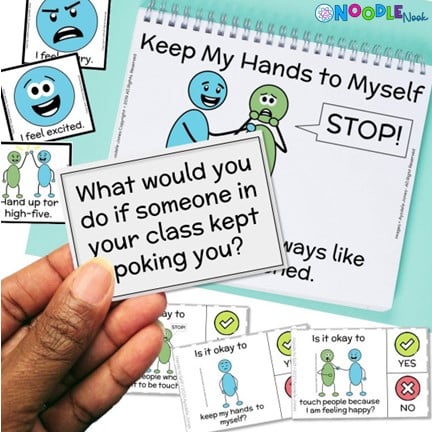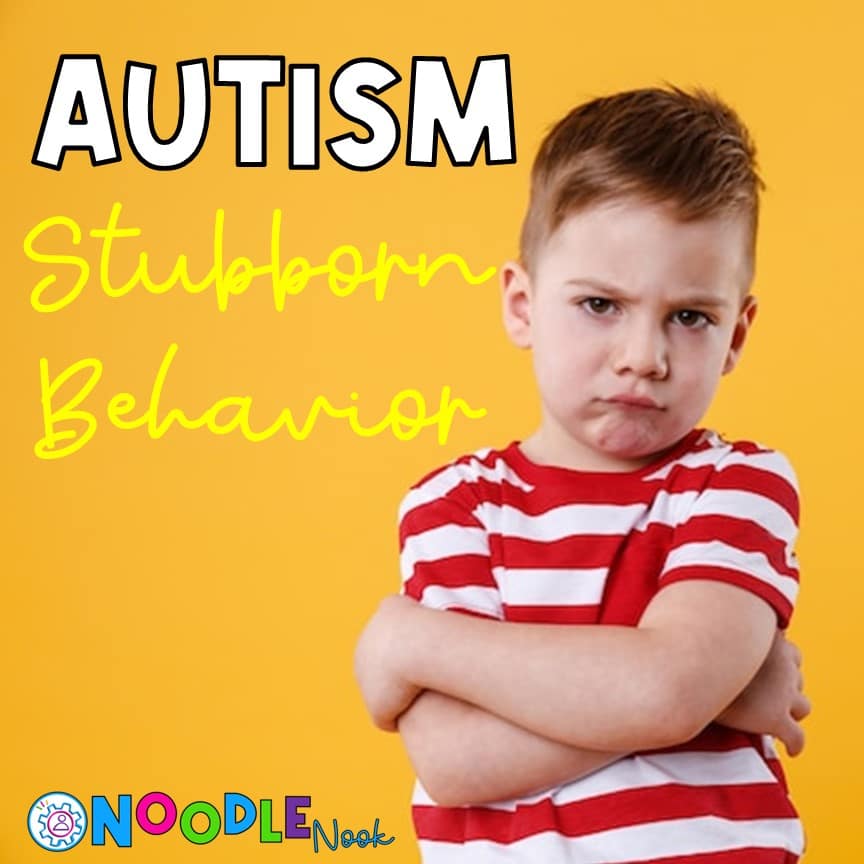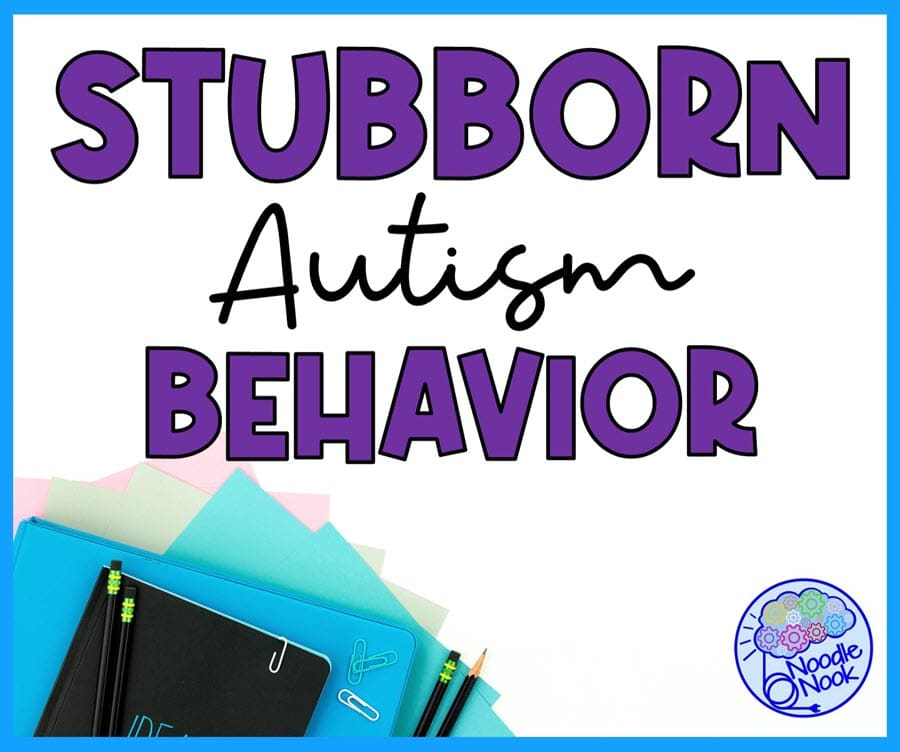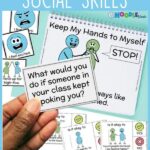Has it ever happened to you? Have you ever found yourself locked in a battle of wills with a stubborn student? Talk about a Lose-Lose situation! As a teacher, you play an important role in the development and success of your students, including those with autism spectrum disorder (ASD). Autism stubborn behavior can be particularly challenging. With the right strategies, however, you can escape that doomed battle of wills and also teach long-term skills for success.
Why are Kids with Autism so Stubborn
Children with autism may display stubborn behavior for a variety of reasons.
One possible explanation is that they may have difficulty adapting to changes in their routines or surroundings, which can cause them to become anxious and resistant to new situations.
Sometimes children with autism may struggle with communication and social interactions, which can lead to frustration and a lack of understanding of expectations. This can manifest as stubbornness or a refusal to comply with requests.
Finally, sensory issues can also play a role in stubborn behavior, as certain stimuli may be overwhelming or uncomfortable for the child. Understanding these underlying factors can help teachers and caregivers develop effective strategies to address stubborn behavior in children with autism.
Knowing the reason will help to identify the best strategy to help. Here are five specific strategies to help you deal with stubborn behavior in children with autism:
Utilize Visual Cues
One of the most effective strategies is to use visual cues. Many children with autism are visual learners and may have a hard time understanding verbal instructions. To help with this, try using visual aids such as pictures, diagrams, and written instructions.
This can help your students better understand what is expected of them and make it easier for them to follow through on tasks. On top of that, most of these are evidence-based practices proven effective for students with disabilities. That means visual supports should be a part of your daily tasks and classroom routine. It’s the way to set up an early intervention for stubborn behavior.
Here are a few specific ideas you can use:
- Create a visual schedule: Use pictures or written words to create a schedule for the day or week. This can help students with autism understand what activities are coming up and reduce anxiety about transitions. They can also help you maintain a more consistent schedule. Check out the one available from Noodle Nook HERE.
- Use visual aids for instructions: Instead of relying solely on verbal instructions, use pictures or diagrams to help students understand what they need to do. These work for academics, but also to help with a child’s behavior, including challenging behaviors. Think of a calm down sequence and how helpful that could be!
- Use visual timers: For students who struggle with time management, a visual timer can be a great tool. It can help them understand how much time they have left for a particular task and stay focused. You can snag one at the local dollar store, use your phone or computer, or grab this one from Amazon HERE.
- Use social stories: Social stories are short stories that describe a social situation or behavior in a way that is easy for students with autism to understand. They can be used to teach positive behaviors and coping mechanisms. Sometimes stubbornness is actually because a student is not sure how to act or react in a given situation. Social stories totally help with this. Check out the ones from Noodle Nook HERE.
- Incorporate movement breaks: Some students with autism may exhibit stubborn behavior due to sensory overload. Incorporating movement breaks throughout the day can help them regulate their sensory input and improve their behavior. Not only that, they help nearly all learners attend and learn. So get in more break breaks!
Addressing stubborn behavior in students with autism requires patience, understanding, and creativity. Using visual cues is just one of many effective strategies you can use to help your stubborn students.
With the right support and guidance embedded in your daily routine, you can skip the stubborn showdown altogether! So set the stage for success in your classroom with these best practices.
Use Positive Reinforcement
Encouraging good behavior is an essential part of teaching children with autism. Heck, positivity works for neurotypical people too. Positive reinforcement can be an effective way to build on that love of positivity! Instead of using punishment for an unwanted behavior, try rewarding positive behaviors. This could get you out of a stubborn standoff by focusing on the good. Involve verbal praise or something tangible, like a sticker or a small prize to get students motivated.
Here are five specific ideas you can use to encourage good behavior:
- Use a reward chart: Create a chart with your student’s name and a list of positive behaviors you want to reinforce. Each time they exhibit one of these behaviors, add a sticker or checkmark to the chart. When they reach a certain number of stickers, they earn a reward. This is a great way to focus on the good, not the challenging behavior.
- Create a special activity bin: Fill a bin with fun activities, such as bubbles, puzzles, or stickers. Whenever your student exhibits good behavior, they can choose an item from the bin to enjoy. If you want to stretch the time between rewards, add breaks to your schedule. You can also use a token board to build up to the special activity bin reward.
- Have a special activity day: Pick a day of the week to be a “special activity day.” If your student exhibits positive behavior throughout the week, they get to participate in a special activity on that day. This is a great way to stretch the reward and have a child work a long time to get their preferred activity. This may not work for everyone, but for some it’s great.
- Give verbal praise: Sometimes, all it takes is a few positive words to encourage good behavior. Whenever your student does something positive, make sure to give them specific praise. When you are in a stubborn showdown, point out a positive thing to break the tension. It may help you as well to think of positive things.
- Use a token system: Give your student tokens or coins for positive behavior. They can then exchange these tokens for a special prize or activity. I love token boards. They are a magical tool in the classroom when you’re dealing with challenging behaviors. If you want to read more about them, check out this article HERE:
Positive reinforcement works best when it’s consistent and tailored to the individual needs of autistic children and focuses on the child’s behavior.
That means the first step is knowing what your student is willing to work for or likes to be rewarded with. The wrong reward will likely make the situation worse. You have to know what their preferred activities and items are. With a little creativity and patience, you can help your students with autism develop positive behaviors and avoid a dreaded power struggle.
Encourage Communication and Social Skills
Problem behavior, like stubbornness, can sometimes stem from a lack of communication skills and misunderstanding social situations. Social skills and communication are new skills that need to be modeled and directly taught. As a teacher, you can incorporate fun and effective strategies into the classroom to help. Learning better social communication is one of the best strategies to address stubborn behavior in a way that will support their daily life. Here are five specific strategies you can implement:
- Role-playing social situations: This activity can help students practice appropriate social behaviors and interactions in a safe and controlled environment. Teachers can setup social interactions and scenarios specific to student needs. Then students can act them out, while getting guidance and feedback from the teacher as needed.
- Developing a more robust communication system or response mode: For students with communication challenges, teachers can work with speech therapists to develop individualized systems that allow students to communicate more effectively. This may include picture cards, sign language, or other alternative communication methods.
- Practicing reading facial expressions and nonverbal communication: Many students with autism struggle to interpret social cues and nonverbal communication. Teachers can use games and activities that focus on these skills. That can also include practicing identifying different emotions based on facial expressions, reading body language, and overcoming lack of eye contact.
- Social stories to learn social norms: Social stories are short narratives that teach students about social norms and expectations in a specific situation. Teachers can create their own social stories or find pre-made ones online to use in the classroom.
- Playing games to practice turn-taking and how to win or lose: Games that require turn-taking can be a great way to help students learn patience and sportsmanship. Teachers can also use games that focus on how to win and lose gracefully to help students understand the importance of good sportsmanship.
Incorporating these strategies into a K-12 classroom for students with disabilities can be done in various ways, depending on each student’s individual needs and abilities. For example, teachers can incorporate role-playing exercises during social skills groups or integrate communication systems into daily routines. Practicing facial expression recognition can be part of a larger lesson on emotions and empathy, while social stories can be read aloud during storytime or used as a discussion prompt. Games can be played during recess or integrated into classroom lessons as a reward for good behavior. With patience, creativity, and a willingness to try new approaches, teachers can help their students overcome challenges and thrive both academically and socially.
Practice Coping Mechanisms
Let’s explore ways to help our students with autism build coping mechanisms that work for them. Everyone can get overwhelmed at times, and students with autism may need a little extra support to regulate their emotions. Luckily, there are many strategies that can be effective in helping children with autism manage their stress levels. Here are some ideas to get you started:
- Provide visual cues: Use visual aids to help children identify when they are feeling overwhelmed. This could be a chart with different emotions or colors that represent different moods.
- Deep breathing exercises: Encourage children to take deep breaths when they start to feel anxious or stressed. Practice this as a class, and make it a fun activity by having students take turns leading the group.
- Sensory tools: Sometimes the stubbornness is related to sensory overwhelm. When this happens, provide sensory tools such as stress balls, fidget toys, or weighted blankets. These tools can be used to help students manage their stress and anxiety in the moment.
- Calm down corner: When students with autism become overwhelmed, having a designated calm down corner can be incredibly helpful. This space can provide a safe and comforting environment for students to regroup and manage their emotions. Consider including sensory items such as fidget toys, weighted blankets, or noise-cancelling headphones to help students calm down. Check out a great selection of sensory items HERE.
- Practice self-advocacy: Encourage your students to speak up when they are feeling overwhelmed or need a break. Teach them how to ask for help and give them opportunities to practice self-advocacy in the classroom.
Incorporating these strategies into your classroom can help your students with autism build a better coping mechanism. Taking a break, deep breathing or using a stress ball may be just the thing you need to break the stubborn standoff. By providing support and guidance, you can help them manage their emotions and stay focused on their work.
Seek Professional Help
Dealing with stubborn behavior in students with autism can be tough, but remember that you don’t have to do it alone! Seeking professional help can be a game-changer for both you and your students. Child psychologists and mental health professionals can offer guidance and support to help you better understand and manage the behavior of your students. They can also work with you to identify any underlying causes of the behavior and suggest effective treatments. Don’t be afraid to reach out for help when you need it.
- Child Psychologist: A child psychologist is a licensed mental health professional who specializes in working with children and adolescents. They can help diagnose and treat any underlying conditions that may be contributing to stubborn behavior in students with autism. Additionally, they can help develop personalized behavior plans and provide guidance on effective coping mechanisms.
- Behavioral Therapist: A behavioral therapist is a professional who specializes in behavioral interventions. They can help identify the specific triggers for stubborn behavior and develop targeted interventions to address these behaviors. They can also provide training and support for teachers and parents on how to implement these interventions effectively. You may be dealing with a situation that needs something other than traditional discipline techniques, so reach out when you’re at then end of your rope.
- Speech-Language Pathologist: A speech-language pathologist is a professional who specializes in communication disorders. They can work with students with autism to develop better communication skills. That includes understanding and using nonverbal communication, responding appropriately to social cues, and developing effective communication strategies. Deficits in these areas can trigger problematic behavior. Moreover, they deeply impact and autistic person’s life long after graduation. If you need different ways to improve speech, collab with your SLP.
- Occupational Therapist: An occupational therapist can help students with autism develop the skills they need to function effectively in daily life. This can include developing sensory integration skills, improving fine motor skills, and developing strategies for self-regulation and emotional control.
If you’re struggling to deal with stubborn behavior in your students with autism, get help from the professionals who know just what to do. Stubbornness and oppositional behaviour can be common symptoms of autism. Support services are in place to help and these folks are an excellent resource when you’re looking for the most effective treatments and strategies to use in your classroom.
RECAP: Autism Stubborn Behavior
Dealing with stubborn behavior in students with autism can be challenging. With the right strategies and support, it is possible to create a positive and productive learning environment. Teachers can help their students with autism overcome challenging behaviors and thrive in the classroom by:
- Use visual aids
- Implement positive reinforcement
- Encourage communication and social skills
- Practice coping mechanisms
- Seek professional help when needed
By implementing these five strategies, you can move beyond the power struggle and help your students with autism develop the tools they need to succeed beyond the classroom.

